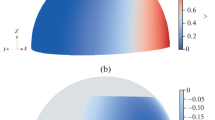Abstract
The problem of electromagnetic wave diffraction by a flat convex screen of arbitrary shape is considered. The numerical solution for the problem is obtained by the method of moments using the parallel programming technology CUDA. As basic and testing functions RWG functions are used. To construct the corresponding RWG elements on CUDA, a simple and fast algorithm of triangulation for a convex screen with an arbitrary boundary is developed. Numerical results are presented for the problem of diffraction by a rectangular screen, as well as by screen octagonal shape. The results obtained for the rectangle are in good correspondence with the results published in previous works. A comparative analysis of the running time of sequential and parallel algorithms is presented. The analysis shows that the method of moments implementation by GPU significantly improves the performance of the algorithm for solving the problem of electromagnetic wave diffraction by the flat metal screens.




Similar content being viewed by others
REFERENCES
T. Nagasaka and K. Kobayashi, ‘‘Wiener-Hopf analysis of the plane wave diffraction by a thin material strip,’’ IEICE Trans. Electr. E100-C, 11–19 (2017).
E. Luz, E. Granot, and B. A. Malomed, ‘‘Analytical boundary-based method for diffraction calculations,’’ J. Opt. (2019). doi 10.1088/2040-8986/ab60c1
M. A. Nethercote, R. C. Assier, and I. D. Abrahams, ‘‘Analytical methods for perfect wedge diffraction: A review,’’ Wave Motion (2020). doi 10.1016/j.wavemoti.2019.102479
D. N. Tumakov and A. R. Tukhvatova, ‘‘Diffraction of an electromagnetic wave by gaps between plates,’’ Lobachevskii J. Math. 33 (4), 364–373 (2012).
D. N. Tumakov, ‘‘Iterative method for solving the problem of scattering of an electromagnetic wave by a partially shielded conducting sphere,’’ Appl. Math. Sci. 8, 5887–5898 (2014).
I. T. Selezov, Y. G. Kryvonos, and I. S. Gandzha, ‘‘Some analytical and numerical methods in the theory of wave propagation and diffraction,’’ in Wave Propagation and Diffraction: Mathematical Methods and Applications (Springer, Singapore, 2018).
K. Shibata and M. Kobayashi, ‘‘Difference between the method of moments and the finite element method for estimation of complex permittivity in liquids using a coaxial probe,’’ in Proceedings of the International Symposium on Electromagnetic Compatibility, 2019.
A. Taflove and S. Hagness, Computational Electrodynamics: the Finite-Difference Time-Domain Method, 2nd ed. (Artech House, Norwood, 2000).
I. P. Molostov and V. V. Scherbinin, ‘‘Application of NVIDIA CUDA technology for numerical simulation of electromagnetic pulses propagation,’’ Izv. Altai State Univ. 85, 39–43 (2015).
Y. Zhang, X. Mei and H. Lin, ‘‘OpenMP-CUDA accelerated moment method for homogeneous dielectric objects,’’ in Proceedings of the IEEE Antennas and Propagation Society International Symposium, 2014.
J. Li, Z. Zhang, et al., ‘‘GPU accelerated non-illuminated graphical electromagnetic computing method with high accuracy,’’ Optik-Int. J. Light Electron Opt. 142, 523–528 (2017).
S. Peng and Z. P. Nie, ‘‘Acceleration of the method of moments calculations by using graphics processing units,’’ IEEE Trans. Antenn. Prop. 56, 2130–2133 (2008).
C. A. Balanis, Antenna Theory: Analysis and Design, 4th ed. (Wiley, New York, 2016).
W. C. Gibson, The Method of Moments in Electromagnetics (Taylor and Francis Group, Abingdon, 2008).
R. F. Harrington, ‘‘Field computation by moment methods,’’ IEEE Trans. Antenn. Prop. 4, 229–231 (1993).
M. N. Sadiku, Elements of Electromagnetics (Oxford Univ. Press, New York, 2001).
R. Mittra and C. A. Klein, ‘‘Stability and convergence of moment method solutions,’’ in Numerical and Asymptotic Techniques in Electromagnetics, Ed. by R. Mittra, Topics in Applied Physics (Springer, Berlin, 1975).
J. A. de Loera, J. Rambau, and F. Santos, Triangulations: Structures for Algorithms and Applications, Algorithms and Computation in Mathematics (Springer, Berlin, 2010).
A. G. Markina, N. B. Pleshchinskii, and D. N. Tumakov, ‘‘On electrical characteristics of tooth-shaped microstrip antennas,’’ in Proceedings of the 2017 EIConRus, 2017, pp. 179–183.
Y. G. Smirnov, M. Y. Medvedik, et al., ‘‘The solution of the problem of electromagnetic wave diffraction on screens of complex shape,’’ Izv. Vyssh. Uchebn. Zaved., Volzh. Reg., Fiz. Mat. 4, 59–72 (2012).
M. S. Rao, R. D. Wilton, and A. W. Glisson, ‘‘Electromagnetic scattering by surfaces of arbitrary shape,’’ IEEE Trans. Anten. Prop. 30, 409–418 (1982).
D. Giniyatova, D. Tumakov, and A. Markina, ‘‘Solving problem of electromagnetic wave diffraction by a metal plate using CUDA,’’ in Proceedings of the IEEE East-West Design and Test Symposium EWDTS’2020 (2020), pp. 324–329.
Cuda Triangulation. https://github.com/Ukio-G/CudaTriangulationRWG. Accessed January 7, 2021.
D. Tumakov, A. Markina, and I. Badriev, ‘‘Fast method for designing a well-matched symmetrical four-tooth-shaped microstrip antenna for Wi-Fi applications,’’ J. Phys.: Conf. Ser. 1158 (4), (2019).
A. Markina and D. Tumakov, ‘‘Designing the four-tooth-shaped microstrip antenna for Wi-Fi applications,’’ in Proceedings of the 1st International Conference on Control Systems, Mathematical Modelling, Automation and Energy Efficiency SUMMA’2019, pp. 25–30.
Funding
This paper has been supported by the Kazan Federal University Strategic Academic Leadership Program.
Author information
Authors and Affiliations
Corresponding authors
Additional information
(Submitted by E. E. Tyrtyshnikov)
Rights and permissions
About this article
Cite this article
Giniyatova, D.K., Tumakov, D.N. & Markina, A.G. Solving the Problem of Electromagnetic Wave Diffraction by a Flat Screen Using CUDA. Lobachevskii J Math 42, 1335–1344 (2021). https://doi.org/10.1134/S1995080221060081
Received:
Revised:
Accepted:
Published:
Issue Date:
DOI: https://doi.org/10.1134/S1995080221060081




